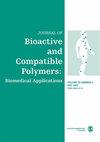In situ forming gelatin: Cyclodextrin hydrogels prepared by “click chemistry” to improve the sustained release of hydrophobic drugs
IF 2.1
4区 生物学
Q3 BIOTECHNOLOGY & APPLIED MICROBIOLOGY
引用次数: 0
Abstract
Injectable hydrogels offer a wide range of attractive benefits in drug delivery applications, such as non-invasive administration, easy drug incorporation and locally controlled release at the target sites. Herein, we designed a simple and efficient method to prepare injectable hydrogels composed of gelatin and cyclodextrin (CD) for high loading capacity of hydrophobic drugs. The hydrogels were formed by thiol-functionalized gelatin (GSH) and βCD-vinyl sulfone (βCD-VS) as cross-linker, via thiol-ene “click” chemistry. Hydrogels comprising of different cross-linker feed amount were investigated in terms of their physico-chemical properties, such as gelation time, mechanical strength, swelling ratio, porosity and degradation rates. For the use as a drug delivery vehicle, dexamethasone (DEX), a commonly anti-inflammatory, immunosuppressive but poorly water soluble drug was chosen to show the high drug loading capacity and prolonged drug release of hydrogels. The drug release was found to be depended on the concentration of βCD-VS due to the drug-CD interaction. In vitro cytotoxicity experiment also showed the cell compatibility of these hydrogels against human dermal fibroblasts. In summary, we expect this gelatin-CD “click” hydrogel will be a promising candidate for localized and long-term delivery of hydrophobic drugs. Graphical Abstract原位成型明胶:通过“点击化学”制备环糊精水凝胶,改善疏水药物的缓释
可注射水凝胶在药物递送应用中提供了广泛的吸引力,例如非侵入性给药,易于药物合并和在目标部位局部控制释放。本研究设计了一种简单、高效的方法制备由明胶和环糊精(CD)组成的可注射型水凝胶,以提高疏水药物的负载能力。以巯基功能化明胶(GSH)为交联剂,以β cd -乙烯基砜(βCD-VS)为交联剂,通过巯基“咔嗒”反应形成水凝胶。研究了不同交联剂投加量的水凝胶的理化性质,如凝胶时间、机械强度、溶胀率、孔隙率和降解率。地塞米松(dexamethasone, DEX)是一种常见的抗炎、免疫抑制但水溶性较差的药物,具有较高的载药量和较长的水凝胶释药时间。由于药物- cd相互作用,药物释放依赖于βCD-VS的浓度。体外细胞毒性实验也显示了水凝胶对人真皮成纤维细胞的细胞相容性。总之,我们预计这种明胶- cd“点击”水凝胶将成为一种有希望的局部和长期递送疏水药物的候选者。图形抽象
本文章由计算机程序翻译,如有差异,请以英文原文为准。
求助全文
约1分钟内获得全文
求助全文
来源期刊

Journal of Bioactive and Compatible Polymers
工程技术-材料科学:生物材料
CiteScore
3.50
自引率
0.00%
发文量
27
审稿时长
2 months
期刊介绍:
The use and importance of biomedical polymers, especially in pharmacology, is growing rapidly. The Journal of Bioactive and Compatible Polymers is a fully peer-reviewed scholarly journal that provides biomedical polymer scientists and researchers with new information on important advances in this field. Examples of specific areas of interest to the journal include: polymeric drugs and drug design; polymeric functionalization and structures related to biological activity or compatibility; natural polymer modification to achieve specific biological activity or compatibility; enzyme modelling by polymers; membranes for biological use; liposome stabilization and cell modeling. This journal is a member of the Committee on Publication Ethics (COPE).
 求助内容:
求助内容: 应助结果提醒方式:
应助结果提醒方式:


